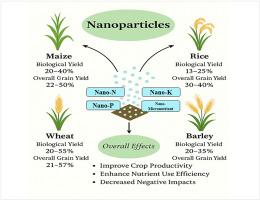Unlocking higher productivity and nutrient use efficiency in cereals through nano-fertilizers
引用次数: 0
Abstract
The rapid increase in global demand for cereals has led to excessive use of conventional fertilizers. While these fertilizers enhance crop yields, they are also associated with environmental degradation, soil and water pollution, and health concerns. In response to these issues, nanotechnology has been introduced as a revolutionary approach in agriculture, offering improvements through advanced practices. Nano-fertilizers, including nano NPK, nano iron, HAP-modified urea nanoparticles, and nano zeolite composite fertilizers, have been studied for their potential benefits. This review examines the application of these nano-fertilizers in three major cereal crops—wheat, maize, and rice. The comparative studies reveal that the biological yield of wheat can be increased by 20–55 %, maize by 20–40 %, and rice by 13–25 % with the use of nano-fertilizers. Furthermore, the overall grain yield of wheat has been found to increase by 20–55 %, maize by 22–50 %, and rice by 30–40 %. It is emphasized that careful management of nano-fertilizer concentrations is essential to avoid any adverse effects on plant health. The review highlights the significant improvements in cereal productivity and nutrient use efficiency offered by nano-fertilizers as a sustainable alternative to conventional methods along with limitations and way forward.

通过纳米肥料提高谷物的生产力和养分利用效率
全球谷物需求的快速增长导致了常规肥料的过度使用。虽然这些肥料提高了作物产量,但它们也与环境退化、土壤和水污染以及健康问题有关。为了应对这些问题,纳米技术作为一种革命性的方法被引入农业,通过先进的实践提供改进。纳米肥料,包括纳米氮磷钾、纳米铁、hap修饰的尿素纳米颗粒和纳米沸石复合肥料,已经研究了它们的潜在效益。本文综述了这些纳米肥料在小麦、玉米和水稻三种主要谷类作物中的应用。对比研究表明,施用纳米肥料可使小麦增产20 ~ 55%,玉米增产20 ~ 40%,水稻增产13 ~ 25%。此外,小麦的总产量提高了20 - 55%,玉米提高了22 - 50%,水稻提高了30 - 40%。作者强调,仔细管理纳米肥料浓度对于避免对植物健康产生任何不利影响至关重要。该综述强调了纳米肥料作为传统方法的可持续替代方案在谷物生产力和养分利用效率方面的重大改进,以及局限性和前进方向。
本文章由计算机程序翻译,如有差异,请以英文原文为准。
求助全文
约1分钟内获得全文
求助全文

 求助内容:
求助内容: 应助结果提醒方式:
应助结果提醒方式:


